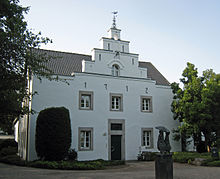Steinbreche House
The house rock crushing is a 1712-built mansion in the district of Alt Refrath of Bergisch Gladbach .
history
The quarries
Elector Johann Wilhelm , known as Jan Wellem, began building Bensberg Castle in 1706 . The building material used included, among other things, the rough Lay (ordinary limestone ) from the ahl Brech (old quarry ) east of today's quarry for normal stone. Today the so-called magic lake is located there . Wirlsches Lay (Wirlschen = petrification , here: shell limestone ) was obtained from the new Brech (the new quarry) - there is now the so-called Kahnweiher . This is the so-called Refrath marble , which was used for decorative parts of the castle facade. Leonard Goudhaire was one of the stone masons from Wallonia who worked on the construction . His task was initially to produce stone for doors and windows as well as the facade design of the Bensberg Castle from the solid limestone found in Refrath.
Steinbreche House
Jan Wellem was so satisfied with Goudhair's work that he gave him a piece of land near the quarries. He had been married to Katharina Beckers since 1703 and built the Steinbreche House in 1712, which is still standing today . Both had several children. The daughter Anna Maria married Otto Siegen in 1728, who bought his wife's siblings their inheritance on the Steinbreche. The Siegen couple had four sons, all of whom remained unmarried and were not interested in the Steinbreche, and four daughters. Only the daughter Katharina Siegen married the powder mill owner and landlord Franz Wilhelm Eyberg in Kesselsdhünn near Wermelskirchen .
The three Juffern
Only the three unmarried daughters (" Juffern " = virgins) remained as common heirs at Haus Steinbreche. They developed extensive entrepreneurial activities by purchasing several lime kilns and land. The three sisters went to church every day. It is said of them that they shared a bright red umbrella that was so big that all three of them could fit under it. It was called the family umbrella . By decision of the Refrath Citizens' Association and Local History Association, the Refrath sculptor Helmut Moos made a sculpture in 1993, which was placed in front of the Steinbreche house.
Expansion into an excursion restaurant
By 1902 restoration rooms, a wine bar, a large dance hall and the covered terrace were built. A bowling alley and a shooting range followed. Other offers for the guests included a maze, a hall with the largest orchestrion in the Rhineland, and 200 bicycles that were loaned out. In the stables there were 60 horses and donkeys that could be rented for riding. The guests were accompanied to the tables by a herald in splendid costume. Boats could be rented for a trip on the boat pond. Today there is a Chinese restaurant in the restaurant. The hall is managed by the Steinbreche community center . The old mansion is inhabited.
Registered monument
The Steinbreche house, Dolmanstrasse 17b, was entered under No. 38 in the list of architectural monuments in Bergisch Gladbach .
literature
- Anton Jux: The Bergische Botenamt Gladbach. The history of Gladbach up to the Prussian era (= series of local publications of the city of Bergisch Gladbach. Vol. 5, ZDB -ID 1222425-x ). City of Bergisch Gladbach, Bergisch Gladbach 1964.
- Gerd Müller: Refrath. History of the districts of Bensberg-Refrath and -Frankenforst. A contribution to the history of the Bergisches Land. Cultural Office of the City of Bensberg, Bensberg 1974.
- Bürger- und Heimatverein Refrath eV: 50 years - a chronicle. Bergisch Gladbach 2002.
Individual evidence
- ↑ a b c d Citizens and Homeland Association Refrath eV: Refrath yesterday and today, Refrath as a destination. Volume 2. Bergisch Gladbach 2009, p. 83.
- ↑ Hans Leonhard Brenner : The history of the lime distillery in Bergisch Gladbach (= series of publications of the Bergisches Geschichtsverein, department Rheinisch-Bergischer Kreis. Vol. 4). Verlag Gronenberg, Gummersbach 1992, ISBN 3-88265-171-7 , p. 56.
- ^ A b Johann Bendel : Homeland book of the district of Mülheim am Rhein. History and description, sagas and tales. 2nd and 3rd edition. Self-published, Cologne-Mülheim 1925, p. 169 (5th edition, facsimile print of the 2nd and 3rd edition. Scriba-Verlag, Cologne 1981, ISBN 3-921232-05-8 ).
Web links
- Kölner Stadt-Anzeiger from 18./19. August 2012: Haus Steinbreche is 300 years old
- Rundschau online: From a manor house to a place of culture
- Nachrichten.net: Haus Steinbreche - Former mansion - 300th anniversary celebration
- The Steinbreche community center
Coordinates: 50 ° 57 ′ 37 ″ N , 7 ° 6 ′ 49 ″ E




